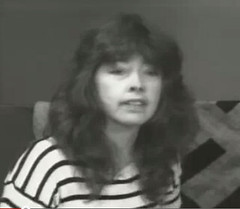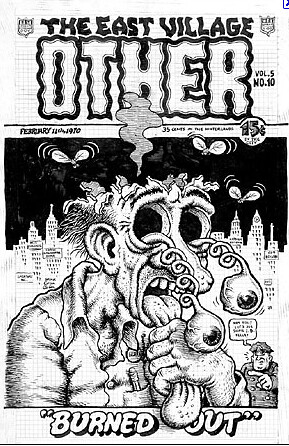Earlier this week, the Arthur L. Carter Journalism Institute launched “Blowing Minds: The East Village Other, the Rise of Underground Comix and the Alternative Press, 1965-72,” with a rousing discussion that’s now archived on the exhibit’s Website, along with new audio interviews with veterans of the Other. Over the course of seven weekend editions of The Local, we’ve heard from all but one of the EVO alumni who spoke on Tuesday’s panel. Here now, to cap off our special series, is the story of Peter Leggieri.
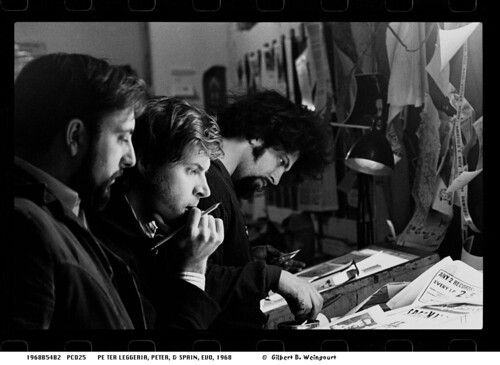 Gil Weingourt Left to right: Peter Leggieri, Peter Mikalajunas, and Spain Rodriguez.
Gil Weingourt Left to right: Peter Leggieri, Peter Mikalajunas, and Spain Rodriguez.From the first day that I began working at The East Village Other, I was overcome by the sense that it was not only a newspaper but a strange and magical ship on a voyage with destiny. It seemed as though each issue printed was a new port of call, and the trip from one issue to the next, a new adventure. Many of EVO’s crew members expressed that same weird feeling – a sense of excitement and creative power.
And what a crew that was! No one was recruited. I don’t recall a resume ever being submitted. They all simply showed up and started working. EVO’s crew might just have been the greatest walk-on, pick-up team in the history of journalism. She was The Other but her staff of artists, poets, writers, photographers and musicians affectionately called her EVO. Her masthead bore a Mona Lisa eye. EVO created a cultural revolution and won the hearts and minds of a generation. She was the fastest ship in the Gutenberg Galaxy.
In the Beginning
I was the anonymous Other, the one editor-owner unknown to the public. I did not party. I did not schmooze with the literati or seek publicity. I had no time for such things. I worked seven days a week, 20 hours a day and, because of law school, I had to be sober. My friend, the poet John Godfrey, told me that I was afflicted with a Zen curse: a hermit condemned to be surrounded by people and events. That was certainly the case for me in the 1960s. Read more…
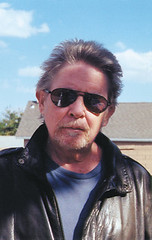 Nancy Naglin Joe Kane
Nancy Naglin Joe KaneA veteran of The New York Ace, High Times, The New York Daily News and many other publications, Joe Kane describes how he got his start at EVO.
When I first migrated to Manhattan from Queens in 1970, it was with dreams of becoming a working scribe, preferably writing Beat fiction (unfortunately, one of the few things I was born too late for) and/or covering film in some capacity. Instead, I landed a boring temp job typing at a downtown insurance firm. During this time, somewhat happier circumstances led me to Screw, where the magazine’s then-art directors, Larry Brill and Les Waldstein, were going halves with publisher Al Goldstein on a new spin-off tab titled Screw X, a satirical variation on Screw (the height of redundancy, no?)
I auditioned for a writing/editing gig, with no guarantee Larry and Les would even get back to me. But a couple of days later, the phone rang in my East Sixth Street pad with promising news from the pair: Seems my work had been extolled by another of their writers, Dean Latimer, who told them it was “almost as good” (accent on almost) as his own stuff and that they should hire me straightaway.
For me, this was a frankly stunning turn of events. It so happened that Dean, whom I had never met, was already something of a personal hero; his “Decomposition” column and other writings were my favorite sections of The East Village Other. I considered Dean one of the most vivid and versatile writers I’d ever read anywhere, one equally adept at reportage, “think pieces,” memoir, criticism and totally devastating satire. That he had encouraging words for my fledgling efforts cheered me no end, and I resolved to thank my benefactor for his unsolicited largesse. Read more…
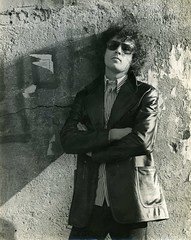 Deanne Stillman Rex Weiner, circa 1971.
Deanne Stillman Rex Weiner, circa 1971.Rex Weiner co-founded The East Village Other’s successor, the pioneering New York Ace (1972–73) and according to his FBI file, was a founding staff member of High Times. He recalls getting his start at EVO.
My first week aboard The East Village Other, its venerable editor-in chief Jaakov Kohn squinted at the name I’d signed to an article, clutched his blue pencil spasmodically, and curled his whiskered lips in disdain. In an Eastern European accent nearly as impenetrable as the cloud of unfiltered Lucky Strike smoke curling from the butt in his nicotine-stained fingers, he declared, “You look more like a Rex to me!”
The newly minted moniker echoed amongst my new colleagues in the vast, shadowy loft. At EVO you had the name you were born with and the name that EVO gave you: Jackie Diamond was Coca Crystal, Alan Shenker was Yossarian, Jackie Friedrich was Roxy Bijou, Jaakov was “The Arab,” Charlie Frick was Zod, and so on. And so with my next byline I was reborn in 1970, a new decade with a new name, and on my way as a writer, of sorts.
I’d walked out of the clanking elevator into the EVO office that fall, a 20-year-old N.Y.U. dropout from upstate and a Lower East Side inhabitant since I was 17. Two of my closest friends from high school were lost, one to Vietnam and the other to heroin, allowing me to nurse a tragic heart tinged with righteous political outrage. With half a dozen porn novels credited to my name — or pseudonym — for a Mafia publisher, and a handful of poems I’d recited at St. Marks in the Bowery, I thought of myself as an established writer. I appointed myself EVO theater critic, filling a staff vacancy, and felt right at home. Read more…
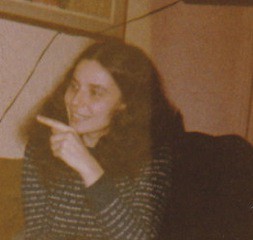 Kathy Streem Lynda Crawford, 1971
Kathy Streem Lynda Crawford, 1971Breathless — not just from the late-night climb up 11 flights to the EVO office on East 12th Street, or the astonishing art by the likes of Yossarian, Spain, Little Moon, Joe Schenkman, Brad Holland, R. Crumb, Kim Deitch, Trina Robbins, and Fred Mogubgub, or by Dean Latimer‘s gorgeous prose, or the thrill of reading Ray Schultz, or from the stunning reportage of Jackie Friedrich, Pat Morris, and Claudia Dreifus, or the amazing true life adventures of Coca Crystal (subduing a would-be attacker with a tune on her guitar) and Steve Kraus, or the Krassner interview by Kathy Streem, or the wondrous music reviews by Richard Meltzer and Charlie Frick (and Charlie’s magical layouts), or Tuli’s poetry and songs, Vincent Titus’ fables, Honest Bob Singer’s film writings, Rex Weiner’s off-off Broadway reviews (he was homeless and theaters were warm), Tim Leary’s communiqués from Algeria, A. J. Weberman‘s illuminating investigative portraits, or the vocal harmonies of Steve Heller, Latimer, and Schultz; but also from EVO’s coverage of the major events of the time: efforts to stop the Vietnam War, the Pentagon Papers, the Panther 21 trial, American Indian Movement protests, the murder of George Jackson, the Attica uprising, and Bob Dylan’s 30th birthday party, all produced at high intensity under editor Jaakov Kohn‘s benign leadership.
“EVO is not a tit!” I remember editor Allen Katzman telling several of us when salaries were slashed to the single digits, and then disappeared, during the post–salad days of the early 1970s — my tenure.
I waitressed to pay the rent on my $51-per-month apartment on East Sixth Street and to be able to eat a little more than the nightly fare of free chicken wings and chickpeas at Max’s Kansas City that many subsisted on. The EVO piece I wrote that is most remembered came out of that gig at a deli on Christopher Street when John and Yoko happened in one night and I interpreted their relationship through bits of conversation, body language, and by dissecting leftover pieces of blueberry blintz (A. J. gave me kudos for that one); it was reprinted in the Berkeley Barb and a bunch of other papers too. Read more…
 A.J. Weberman, Yossarian, Vincent Titus
A.J. Weberman, Yossarian, Vincent TitusHow One-Legged Terry became a member of A.J. Weberman’s circle fades into the mists of memory. Surely, he fit the mold of a Weberman associate with his good humor and dominant, eccentric personality. I met Terry along with a number of people A.J. had acquired from a series of “Dylanology” lectures he had given at Manhattan’s New School for Social Research. This was during a five-month period in 1970 in which I had crossed the country with friends in a (then almost requisite) Volkswagon bus, to spend time with the underground comix community, which by then had assembled in San Francisco.
Terry went by the full moniker of Terry Noble in the United States and Terry Ephraite in Israel, where he had gone to work on a kibbutz after finishing his education. While there, he had been assigned to work atop a hopper that loaded agricultural produce into a machine for processing. His job was to assist in moving the produce from a conveyer that lifted the material to the hopper. After a few days on the job, the platform on which he was standing collapsed, dumping him into the machinery and mangling his left leg. What was left had to be amputated just above the knee. As he remembered his thoughts at the time, they were about the loss of his shoe, one of a pair he had recently bought.
When he sought compensation for his loss, it was revealed that the platform had also collapsed in the recent past, costing another Jewish-American volunteer a leg. Terry surmised that it made more sense to assign an expendable American to the dangerous positions than to fix the underlying fault. Because of the negligence involved, Terry had won a settlement of about $50,000 for his loss. Read more…
Coca Crystal (born Jackie Diamond) was EVO’s self-described “gatekeeper,” receptionist, sometime reporter and sometime model until the bitter end, when, as staff and resources dwindled, she became its defacto publisher (she financed the final two issues out of her own purse). Here, she describes how she got her start.
The first time I set foot in the EVO office, it was in the fall of 1969 and I had come to visit with a college friend, Barbara, who was EVO’s secretary.
The office was located on the third floor of the Fillmore East building on Second Avenue and Sixth Street. The place was a wreck. It was freezing, the garbage cans were overflowing, cigarette butts were everywhere, and the walls were covered in fabulous cartoons by the best in underground comix: R. Crumb, Kim Deitch, Spain Rodriguez, Yossarian, Shelton, Art Spiegelman, just to name a few. It was chaos, but a kind of cool chaos.
The office was in a frenzy to get copy ready for the typesetter, and I was asked if I could type. I said I could and was given the job of typing up the classifieds. I had never seen such weird ads. (“Dominant Iguana seeks submissive zebra,” sex ads, odd employment opportunities, legal advice for pot busts). I had to type while sitting on Allen Katzman’s lap (his idea), wearing my winter coat and gloves. When I had completed the classifieds I was told the other secretary, Marcia, was leaving and I could have her job if I wanted it. The pay was $35 a week. I took the job. Read more…
From 1965 to 1972, it revolutionized ‘The Good News,’ and shook the foundations of the existing print and visual media. After seven years, it went just as it came – in a hail of livingness. In true American phantasmagoria, it was a legend in its own time.
Initiated by poets, painters, artists, seers, perverts and prophets, it shared its pages with the likes of Buckminster Fuller, Timothy Leary, Robert Crumb, Ishmael Reed, Allen Ginsberg, Lenny Bruce, The Beatles, Bob Dylan, Baba Ram Das, Jerry Rubin and Abbie Hoffman – the conspiracy of the 1960s.
The East Village Other had a consciousness which was created. The News needing a shoe-up to come alive was new to an unconscious civilization. It was more than Print, it was Imprint. An indelible biologue, the East Village Other made even The New York Times seem to come alive. Headlines, columns, advertisements, propaganda and prosletyzing made the “form of the newspaper an adjunct of reality . . .”
The above was written by the late Allen Katzman, poet and co-founding editor of the East Village Other, one of the pioneering underground newspapers. Over the next six weeks, The Local will journey back to the East Village of the mid-1960s and early 1970s with special weekend editions, culminating in an exhibit and party on Tuesday, Feb. 28. We hope you’ll join us for “Blowing Minds: The East Village Other, the Rise of Underground Comix and the Alternative Press, 1965-72.” Full registration details for this free event are at EastVillageOther.org, where you’ll soon also be able to find archival material, ephemera, photographs, and EVO issues. Read more…









